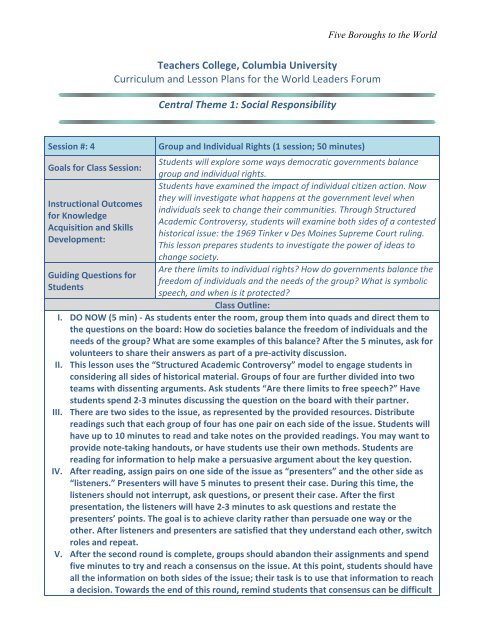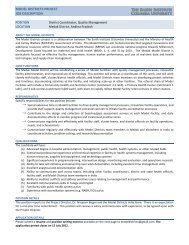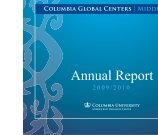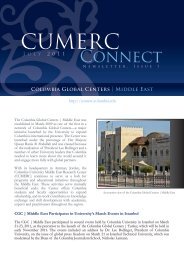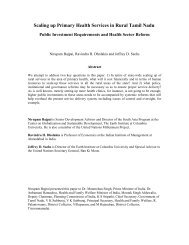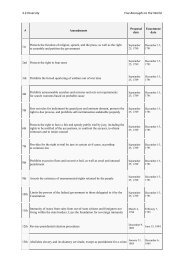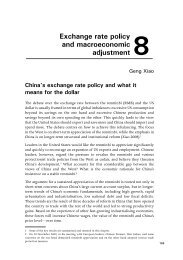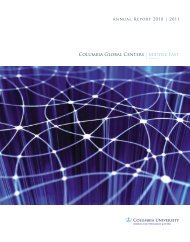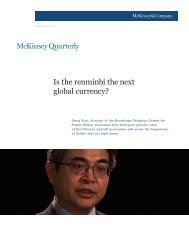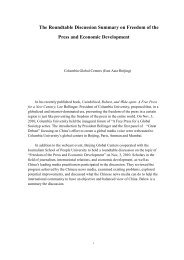Lesson 4 - Columbia Global Centers - Columbia University
Lesson 4 - Columbia Global Centers - Columbia University
Lesson 4 - Columbia Global Centers - Columbia University
Create successful ePaper yourself
Turn your PDF publications into a flip-book with our unique Google optimized e-Paper software.
Five Boroughs to the World<br />
Teachers College, <strong>Columbia</strong> <strong>University</strong> <br />
Curriculum and <strong>Lesson</strong> Plans for the World Leaders Forum <br />
Central Theme 1: Social Responsibility <br />
Session #: 4 <br />
Goals for Class Session: <br />
Instructional Outcomes <br />
for Knowledge <br />
Acquisition and Skills <br />
Development: <br />
Group and Individual Rights (1 session; 50 minutes) <br />
Students will explore some ways democratic governments balance <br />
group and individual rights. <br />
Students have examined the impact of individual citizen action. Now <br />
they will investigate what happens at the government level when <br />
individuals seek to change their communities. Through Structured <br />
Academic Controversy, students will examine both sides of a contested <br />
historical issue: the 1969 Tinker v Des Moines Supreme Court ruling. <br />
This lesson prepares students to investigate the power of ideas to <br />
change society. <br />
Are there limits to individual rights? How do governments balance the <br />
Guiding Questions for <br />
freedom of individuals and the needs of the group? What is symbolic <br />
Students <br />
speech, and when is it protected? <br />
Class Outline: <br />
I. DO NOW (5 min) -‐ As students enter the room, group them into quads and direct them to <br />
the questions on the board: How do societies balance the freedom of individuals and the <br />
needs of the group? What are some examples of this balance? After the 5 minutes, ask for <br />
volunteers to share their answers as part of a pre-‐activity discussion. <br />
II. This lesson uses the “Structured Academic Controversy” model to engage students in <br />
considering all sides of historical material. Groups of four are further divided into two <br />
teams with dissenting arguments. Ask students “Are there limits to free speech?” Have <br />
students spend 2-‐3 minutes discussing the question on the board with their partner. <br />
III. There are two sides to the issue, as represented by the provided resources. Distribute <br />
readings such that each group of four has one pair on each side of the issue. Students will <br />
have up to 10 minutes to read and take notes on the provided readings. You may want to <br />
provide note-‐taking handouts, or have students use their own methods. Students are <br />
reading for information to help make a persuasive argument about the key question. <br />
IV. After reading, assign pairs on one side of the issue as “presenters” and the other side as <br />
“listeners.” Presenters will have 5 minutes to present their case. During this time, the <br />
listeners should not interrupt, ask questions, or present their case. After the first <br />
presentation, the listeners will have 2-‐3 minutes to ask questions and restate the <br />
presenters’ points. The goal is to achieve clarity rather than persuade one way or the <br />
other. After listeners and presenters are satisfied that they understand each other, switch <br />
roles and repeat. <br />
V. After the second round is complete, groups should abandon their assignments and spend <br />
five minutes to try and reach a consensus on the issue. At this point, students should have <br />
all the information on both sides of the issue; their task is to use that information to reach <br />
a decision. Towards the end of this round, remind students that consensus can be difficult
Five Boroughs to the World<br />
to achieve. Ask if there were groups that could not reach consensus, and share their <br />
differences. <br />
VI. For the last 10 minutes, students should complete the provided self-‐reflection rubric and <br />
share what they learned about free speech from the activity. Were groups able to reach a <br />
consensus? If so, what was the final viewpoint? If not, what were points of dissension? <br />
Lecture Notes / Key Discussion Points <br />
Teachers should emphasize the different issues that <br />
involve considerations of group needs and individual <br />
rights. Examples include free speech, freedom of <br />
religion, reproductive rights, taxation, and access to <br />
education. <br />
Key terms to review are: <br />
Rights; <br />
balance of power <br />
Supreme Court; freedom of speech <br />
Individual; collective; Bourgeois <br />
Learning Activities: <br />
Assessment / <br />
Evaluation (primarily <br />
in-‐class): <br />
Readings: <br />
F Instructor Tips: Review the role of the <br />
U.S. Supreme Court in determining legal <br />
disputes that involve individual rights. <br />
FThis lesson works well with many other <br />
Supreme Court cases, or with a study of the <br />
Bill of Rights. <br />
F Encourage students to draw upon their <br />
own beliefs regarding these issues, but <br />
remind them to focus “on the facts” of the <br />
provided case. <br />
Structured Academic Controversy is a proven technique that encourages <br />
students to investigate both sides of an issue that has no established <br />
answer. Students will engage the material in an effort to understand both <br />
sides. In this case, the eternal question is how governments balance the <br />
rights of individuals against the needs of the group. Students will <br />
incorporate new information into their existing understanding of an issue. <br />
Have students complete the “Self Assessment for Persuasive Oral <br />
Communication” rubric. The rubric is set up so that teachers can make <br />
two rubrics with each sheet of paper. <br />
Teachers should also look for holistic signs that students are engaged in <br />
the S.A.C. activity. For example, they should look for examples of good <br />
listening and speaking skills as students share their information. <br />
Tentative: <br />
1. Optional Course Reader: Little Prince <br />
2. “Individual Rights” reading packet, including the Preamble to the <br />
Universal Declaration of Human Rights <br />
3. “Group Needs” reading packet, including selections from The <br />
Communist Manifesto <br />
⇒ http://www.streetlaw.org/en/landmark.aspx <br />
⇒ http://crfc.org/ <br />
⇒ Taking a Stand: Challenges and Controversies in Reproductive Health, <br />
Maternal Mortality, and HIV/AIDS (transcript) <br />
http://www.worldleaders.columbia.edu/events/taking-‐stand-‐<br />
Teaching Resources: <br />
challenges-‐and-‐controversies-‐reproductive-‐health-‐maternal-mortality-‐and-‐hivaids<br />
<br />
⇒ Climate Change: The Leadership Challenge of Our Age, Kofi Annan <br />
http://www.worldleaders.columbia.edu/events/gabriel-‐silver-memorial-‐lecture-‐kofi-‐annan<br />
<br />
Materials Needed: • Copies of the divided readings, grouped for a Structured Academic
Five Boroughs to the World<br />
Controversy involving pairs of students on each side of an issue. <br />
• Self-‐Assessment rubric <br />
• Teacher’s discretion: handouts for taking notes


